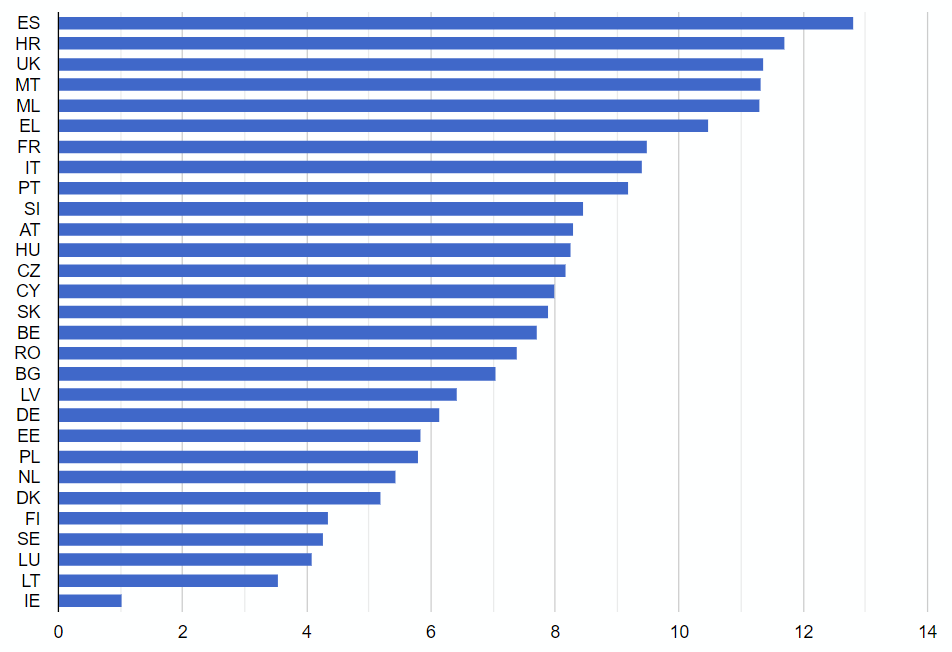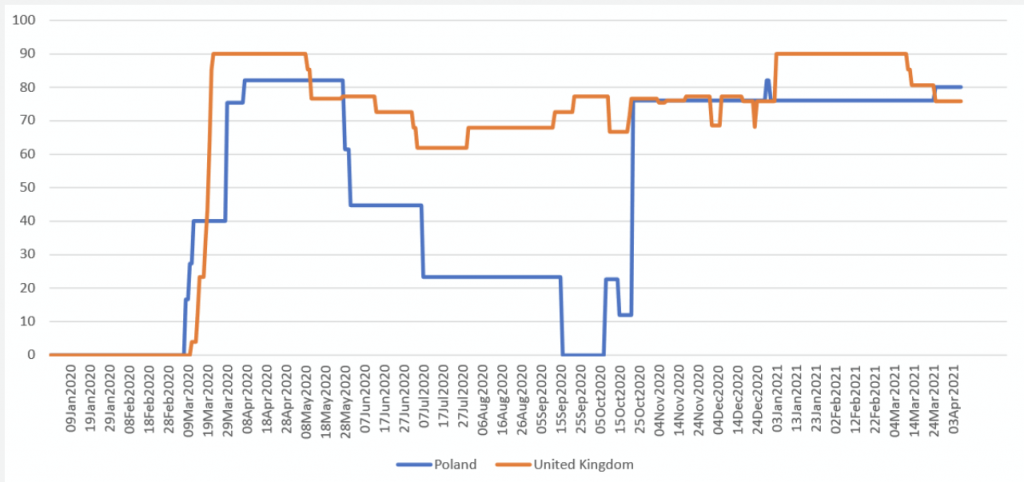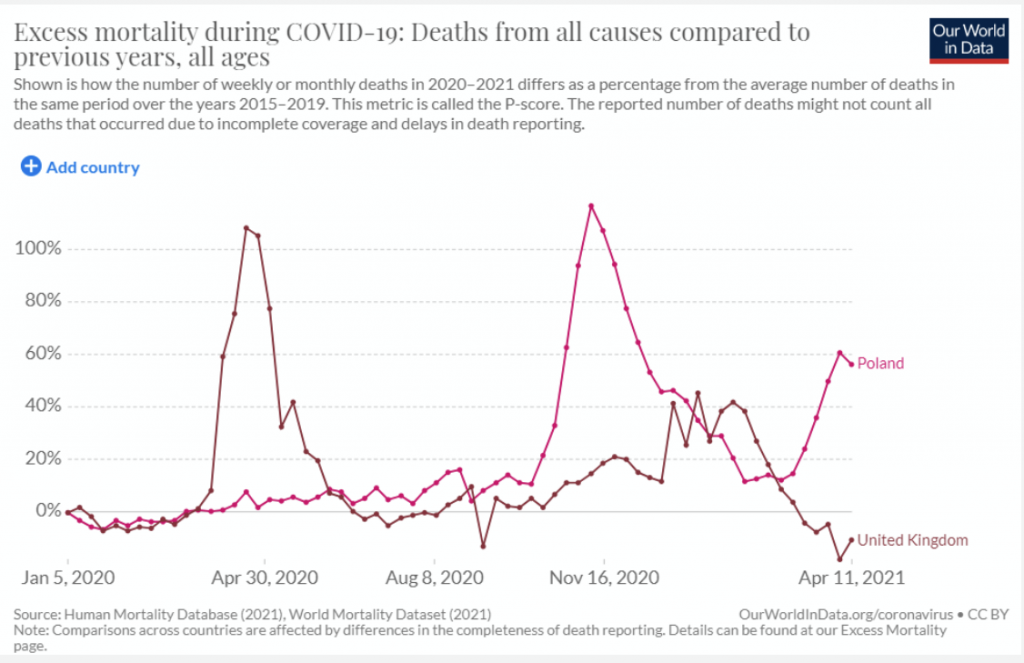Poland has managed to avoid the same level of economic damage experienced in other European countries during the pandemic. However, as Paweł Bukowski and Wojtek Paczos write, contrary to government claims of able stewardship, it is good fortune, prioritising GDP over health, and restrictions centred more on personal than on economic freedoms that explain why Poland has so far remained relatively unscathed.
Subscribe to the weekly LSE Blogs newsletter to receive the latest articles in your inbox.
In 2020, Poland’s GDP contracted by “only” 3.5%, significantly less than the OECD average of 5.5%. In the UK, this figure stood at a staggering 9.9%. While unemployment rates have soared across Europe, the official Polish figures have hardly budged, and are the lowest in the EU according to the latest Eurostat figures.
We should keep in mind that the Polish economy was also performing very well before the pandemic. It had been forecast to grow by 3.1% in 2020, according to the IMF’s World Economic Outlook from October 2019. However, the Polish economy’s drop to 6.6 percentage points below the expected growth figure is still a milder slowdown than in many other countries. For instance, in the case of the Czech Republic it was 8.1 p.p. (from +2.6% to -5.5%), Hungary 8.3 p.p. (from +3.3% to -5%), the UK 11.4 p.p. (from +1.4% to -10%), and Spain almost 13 p.p. (from +1.8% to -11%).
Figure 1: GDP growth shortfall in 2020 (2019 forecast vs 2021 estimate)
Source: Compiled by the authors.
While the Polish economy has clearly managed to navigate the pandemic relatively well thus far, the reasons for this are less clear. The country’s government has been quick to claim the success of its various anti-crisis measures.
The reality, however, is that the Polish response to the economic fallout was neither more innovative nor more generous than those of other countries. According to Eurostat, public spending rose by 9.1% of GDP in Poland between the first and third quarters of 2020, while the EU average in that period was 10.1%. Contrary to government claims, we think that a relatively lax approach to economic lockdown and a bit of sheer luck are the main reasons for the relatively good performance of the Polish economy.
Getting lucky in the first wave
By “sheer luck” we mean all the factors that are beyond the direct control of policies, but that nevertheless affected the transmission of the pandemic and the country’s economic fortunes. Poland was “lucky” in three important respects: its semi-peripheral location and its geographic as well as economic structures. As we will argue, those factors markedly affect the trade-off between the economy and public health.
Due to its semi-peripheral location, the first Covid-19 case appeared in Poland relatively late, giving the government more time to prepare and implement a lockdown strategy. The first restrictions were introduced when the 7-day average of daily cases stood at just nine – rather than 674, as was the case in the UK. New research by the IMF suggests that early but tight lockdowns are most effective in containing the spread of the virus. They are also (potentially) the least harmful to the economy because, if successful, they can be lifted more quickly.
Second, Poland’s geographical structure meant that the “natural” speed of transmission in Poland was slower than in more densely populated western European countries. In Poland, 40% of the population lives in the countryside, which greatly limits the number of daily contacts. The “lived density” of the population in Poland equals only 196 per populated square kilometre, compared to 531 in the UK.
Restrictions: when, what and how?
During the first spring 2020 wave of the pandemic, there was no statistically significant increase in the number of excess deaths (above the five-year average) in Poland and the economy was doing well. The policy of early and tight restrictions circumvented the painful trade-off between health and economy.
This changed dramatically during the second autumn wave of the pandemic that reached its peak in November. The government then implemented a wait-and-see approach, introducing belated measures that ultimately proved less adequate. This can be interpreted as favouring the economy over health.
In the figure below, we modify the Oxford Covid-19 stringency index to show the composite measures that are most harmful to the economy. The original index is based on nine indicators rescaled to a value from 0 to 100, where 0 is the pre-pandemic situation and 100 stands for the most stringent measures implemented in all categories. Our modification includes six categories that we believe are most harmful to the immediate economic situation.
Figure 2: The economic severity index
Source: Own calculation based on Oxford Covid-19 Government Response Tracker
The graph shows that the Polish restrictions were strict during the first wave and then almost non-existent in the summer. The increase in restrictions in autumn, when compared against the number of cases, is, in our opinion, much belated.
By contrast, in the UK the restrictions were kept high during the summer and the increases in restrictions in the autumn were much better timed. This may have hurt the economy more, but also resulted in much slower transmission during that second, autumn wave.
The difference, in some part, may also be explained by a different approach to restricting economic and personal freedoms in each country. In the UK, for instance, there have been few limits on individuals: masks were never made compulsory outdoors, schools remained open for several months, and – from the authors’ own experience – quarantine enforcement has been relatively lax. However, work-from-home was recommended for almost the entire year. During the lockdowns, Britons could only buy non-essential products online and had no access to any form of indoor services.
By contrast, in Poland masks were made compulsory even on empty streets, schools were fully opened for only six weeks, and those in quarantine were checked on regularly by police officers. However, remote work was only strongly pushed for a few scattered weeks. For most of the past year, Poles could still go to a shopping mall or even visit a sauna.
Our intuition is that the Polish approach put less burden on the economy, while the British one is probably more effective in limiting virus transmission. This is supported by the data relating to the total death toll during the pandemic. We use a measure of “excess mortality” (number of deaths above the five-year average) as these data are free from potential differences in (mis)reporting and classification. The graph below shows that, during the first wave in spring 2020, early and tight lockdown in Poland resulted in virtually no excess deaths, while in the UK delayed restrictions led to excess mortality of over 100%.
Then, however, the situation was almost reversed during the autumn second wave. In the year between March 2020 and March 2021, the UK lost almost 121,000 additional lives, while Poland lost more than 95,400. In relation to the country’s respective populations – with the UK being 80% more populous – Poland had 42% higher excess mortality per capita. Virtually all of the difference falls on the second wave.
Figure 3: Excess mortality during the Covid-19 pandemic in Poland and the UK
Source: Our World in Data
Services suffer, manufacturing booms
Moreover, the composition of the Polish economy also makes it more resilient to lockdown measures. In 2019, 27% of workers were employed in the sectors that were later directly affected by the lockdown (such as hospitality or tourism), compared with 34% in the UK and 37% in Spain, according to Eurostat. Since a smaller part of the economy had to hibernate, the direct effect on GDP was less negative.
But there was also a second, indirect, channel. Poland is the only big EU country that has a growing share of manufacturing in both employment and production. This kept more of the economy humming when the service services sector had to be locked down. Also, thanks to this, the country was able to benefit from the global shift in consumption from services to durable goods induced by the pandemic.
Size matters too. A big domestic market reinforces the positive effects of the business-friendly lockdown and a resilient economic makeup. Smaller countries in the region, such as Hungary or Slovakia, are more dependent on the economic situation in the rest of Europe. The larger economic fallout in Germany or the UK will thus drag down smaller economies more. Because of its size, Poland’s domestic economy could in part compensate for the loss of external demand.
Poland and the UK pursued different paths during the first and second waves of COVID-19, providing a natural experiment on how the form and timing of lockdown policies can affect economic slowdown and virus containment. Moreover, the sectoral composition of the economy and geographical distribution of the population also play crucial roles.
Although the performance of the Polish economy during the pandemic appears surprisingly robust, we do not think it was the result of a thought-through strategy. On the contrary, percentage points in GDP figures can never justify the price of almost 100,000 excess deaths. A price that, as the first wave in Poland demonstrated, was entirely avoidable.
Subscribe to the weekly LSE Blogs newsletter to receive the latest articles in your inbox.
Note: This article first appeared at Notes From Poland and is republished with permission. The article gives the views of the authors, not the position of EUROPP – European Politics and Policy or the London School of Economics. Featured image credit: European Council







From the standpoint of living in Poland, I think your analysis is bang-on. Also, Poland may be reacting more quickly post-pandemic, as in the “Polish Deal” released with great fanfare by Law and Justice (PiS) last Saturday, May 15th (presumably after this article was written), the main policy being a dramatic restructuring of the personal income tax structure, with increased effective progressivity redistributing net income from the well-paid to the poorer. While this was mainly under the guise of greatly increasing the health insurance premium for many people (to a flat 9% of income, non-deductible), a side-effect, probably intentional, is to further reduce the tax-share income of local government while strengthening the centre. It will also reduce the incentive for self-employment, a pandemic-resilient feature of the economy which was not discussed in the article.
There are many odd features in Poland’s tax and social insurance schemes, and we are very good at exploiting these features, but in the past year PiS have resolutely closed off several lucrative loopholes. This will appeal greatly to the lower middle class base of PiS, and probably guarantee success in the next general election even without the innumerable abuses of the constitution which Kaczyński’s regime is continully perpetrating while extending Putin-Orban style authoritarian state capture.
I do not think it was luck. Poland was one of the EU countries which immediately closed its borders and introduced social distancing in response to pandemic.
This allowed to reopen economy relatively fast and to avoid overreaction to the second waive.
A very different pattern that th he response of the UK, which was slow to react initially, but also slow to restart the economy.
Poland was not affected as much because Poles are hard-working and creative people what have been proved over centuries. And doesn’t rely on tourism as much. Look at Spain and Greece, these countries rely on tourism heavily and care more how to rip off tourists and about siesta rather than hard work ethos. Also, Poland is 3rd major supplier for Germany, this hasn’t stopped during pandemic but helped the economy going.
For the same reasons Poland didn’t have crisis in 2008 because it is much less owned by international finance than other richer countries. We Poles tend to think in terms of national interest before we do something, whereas western people are apathetic and care about their own pockets, bored about easy life.
Poland is a cheap labor hub of EU manufacturing. Less dependent on services or tourism. No mystery here.
Poland only has a small auto sector — a sector that was very badly hit.
PwC said the current government has improved the tax system more than all previous governments since 1990 put together, putting public finances on a sound footing.
Funny how somethnig good is called luck, something bad is blamed on the government you don’t like
More than half of the excess deaths in Poland were due to lockdown and paralyzed healthcare. It is already known that the epidemic kills 0.3% of the population, and the lockdown cannot prevent it, but only postpone it.
The economy did not collapse so much, because Poles began to actively fight the restrictions. The mechanisms of collective conspiracy developed during communism and the partitions allowed to ignore the restrictions in solidarity by both employers and employees as soon as it turned out that the risk posed by the epidemic was greatly exaggerated. Especially the lack of danger for children meant that people took the risk of the disease, because Poles were aware that in the long term the economic consequences for families carried a greater danger.
Poland’s GD’s drop was 2.7, not 3.3 according to last update.
Btw Polish automotive sector is not so small as one comment says.
Poland manufacturing growth is remarkable. A friend told me it is because Germany outsource a lot to Poland.